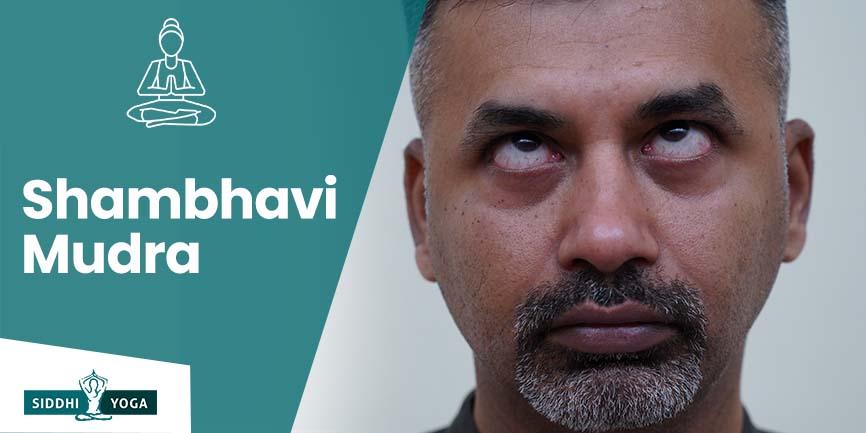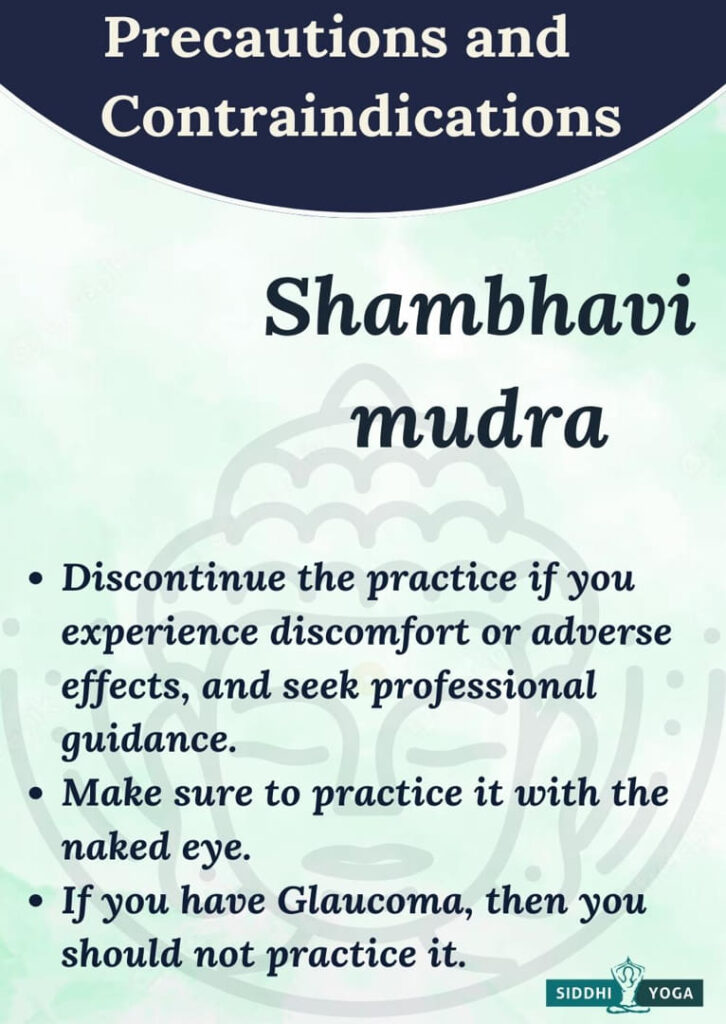
A step-by-step guide to the meaning and benefits and how to do this Shambhavi Mudra – an important mudra for spiritual development.
Definition – What is Shambhavi Mudra and its Meaning, References, and Mythology?
Shambhavi Mudra is one of the Mudras or seals. It is best known for its effects on the eyes. This Mudra involves specific movement of the eyes, through which we try to gaze or concentrate on the Third eye Chakra or Ajna Chakra (or the area between the eyebrows). This Mudra can be loosely translated into English as “Eyebrows center gazing Mudra.” However, this name is not enough to describe its true potential.
This Mudra is mainly performed while sitting in a comfortable meditative posture. However, it can also be practiced while assuming different other types of postures, such as the seated Mandukasana or frog pose.
The word Sambhavi is derived from Lord Shiva (Major Hindu deity, Lord of destruction), also known as Shambhu. The word Shambhavi describes the feminine version of Lord Shiva. It is believed that Lord Shiva blesses the one who practices it.
This Mudra has been tested to give a soothing effect. People who practice it experience the next level of calmness in their minds. This Mudra helps in relieving stress from the mind. Some people also believe that this Mudra is among the best Mudra techniques that Yoga offers. It helps to discover a new level of consciousness. This helps to keep our minds in a better and healthy state.
If you start practicing the Shambhavi Mudra, it will help to improve your Meditation practice. Your mind will become still. It is also believed that Shambhavi Mudra is synonymous with that of Kundalini Shakti, as it is believed that when we practice this Mudra, it helps to awaken the Kundalini shakti from the Muladhara Chakra to Third Eye Chakra, Where Shambhu meets Shambhavi.
Also See: Online Yoga Teacher Training
Alternate Names of Shambhavi Mudra
Eyebrows center gazing Mudra, Bhrumadya Drishti.
How to Do Shambhavi Mudra
- This Mudra is based on the specific movement of the eyes, where we gaze towards the center of our eyebrows.
- To start with this Mudra practice, come to any seated comfortable meditative posture. You can even try Thunderbolt Pose or Vajrasana.
- Take a deep breath and rest your palms comfortably on your knees. You can even assume Gyana Mudra or Dhyana Mudra.
- Now, gently close your eyes and relax every facial muscle, unclench the jaw, relax the eyebrows, and relax your forehead. Relax your eyes completely.
- After taking a few breaths, gently open your eyes and look forward. Your chin should remain slightly tucked in.
- Now, without moving your head, slowly bring your gaze toward the eyebrows center.
- Keep your eyes open as long as you can or until your tears start to come out. After that, gently close your eyes and relax for a while. Make sure to progress gradually into your practice.
- Practice it 2-5 more times.
- When you relax, make sure not to let any thought enter your mind. You can try to maintain your focus on your breath.
Shambhavi Mudra Benefits

- Practicing this Mudra helps to concentrate at a higher state. So, along the way, it helps to relax the thought process.
- It was proven in a study that if we practice this Mudra, then it can significantly reduce perceived stress and can promote general well-being.
- A survey based on 536 practitioners related to the Isha foundation reported that Shambhavi Mahamudra Kriya reduces the risk of several diseases, such as heart disease and menstrual problems. It also eases disease conditions and medicine usage in chronic diseases.
- In the Isha Foundation survey, it was reported that this Mudra also improves the awareness, quality of sleep, mental capabilities, and relaxation in practitioners.
- This is believed that practicing this Mudra can help to keep the energy flowing from Mooladhara Chakra to the Third Eye Chakra/ Ajna Chakra. So, it can help to awaken the Kundalini Shakti.
- This Mudra increases brain functioning as well.
Shambhavi Mudra Precautions and Contraindications

Similar to all other Mudra practices, it has no side effects.
However, there are a few things to consider.
- If you are dealing with spine-related issues that you cannot practice while seated on the floor, you can also choose to sit on a chair.
- In their initial days, some people can develop mild headaches and dizziness. However, it would get better with practice.
- Make sure to practice it with the naked eye. Remove anything that you wear over your eyes.
- If you have Glaucoma, then you should not practice it.
- Make sure not to strain yourself while retaining your breath.
- If you feel any strain, then release the practice.
When and how long to do Shambhavi Mudra?
- This Mudra can be practiced to improve your thought processing and sharpen your mind.
- This Mudra can help you to remain calm, active, and productive in your day-to-day activities.
- This Mudra can help you to reduce perceived stress.
- For a good result, practice it two-three times a day.
Morning is the ideal time to do any yoga or Mudra. In the morning, at this time during the daytime, our brain is at its best. So, you are more likely to be able to concentrate easily. Therefore, you should practice this Mudra from 4 am and 6 am to get the most effective outcomes.
If you are having difficulty with this during the morning, you can do this Mudra later in the evening too.
It is recommended to practice this Mudra for a minimum of 2-5 times daily. Whether you wish to complete it in one stretch or two threes that last between 5 and 10 minutes, it’s up to you. Based on research, the best way to practice an exercise for at least 10-50 minutes is to get the best benefits of this particular Mudra.
Breathing in Shambhavi Mudra
There are different types of Breathing we can practice with this Mudra:
- Abdominal Breathing, where you expand the stomach maximum out with inhalation and relax your stomach with exhalation. For 10-12 times in a single go.
- If you have been a practitioner for a long time, you can aim for a 1:2 ratio of inhalation to exhalation.
Visualization in Shambhavi Mudra
- Visualize that your eyes can see infinity
- You can see the places where even the light cannot reach.
Affirmation in Shambhavi Mudra
While practicing this, Keep a positive intention. Start with:
“My eyes help me to witness internal beauty in others. I am not limited by external beauty.”
Conclusion
Shambhavi Mudra is a posture that allows the body and mind to relax and heal. It has many benefits, including reducing stress, improving flexibility, and increasing energy levels. If you want to learn more about this Mudra and how to incorporate it into your life, check out our Mudras Certification Course. This course will teach you everything you need to know about 108 different mudras and using these mudras in your yoga practice.